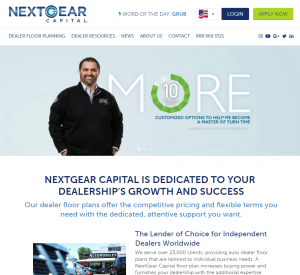 Dealers know that for a majority of car buyers, a customer’s journey to buy a car from a dealership begins online. According to a study from Autotrader and Kelley Blue Book, car buyers spent 60 percent of their time online in the vehicle purchasing process. Because of this, used car dealer advertising is adjusting and pivoting to adapt to the role search plays for a car buyer. Dealers are now spending marketing dollars to increase their presence in the search advertising space.
Dealers know that for a majority of car buyers, a customer’s journey to buy a car from a dealership begins online. According to a study from Autotrader and Kelley Blue Book, car buyers spent 60 percent of their time online in the vehicle purchasing process. Because of this, used car dealer advertising is adjusting and pivoting to adapt to the role search plays for a car buyer. Dealers are now spending marketing dollars to increase their presence in the search advertising space.
In order to ensure that digital used car dealer advertising will show up in front of potential customers, it’s essential to do proper keyword research. Google recently released findings that determined five micro-moments and the five questions that car shoppers will typically ask themselves before a car purchase. Car shoppers will frequently ask themselves: Which car is best? Is this the car right for me? Can I afford it? Where should I buy it? Am I getting a deal?
Dealerships looking to align their search strategy with these top questions car shoppers ask can turn to a few different resources to aid in their keyword strategy.
Analytics
Website analytics are essential in order for dealerships to learn how potential customers reach, and what potential customers look at, on a dealership’s website. Depending on the type of analytics a dealership website may use, there may be opportunity to see keywords users searched for before visiting. Check out the different reports available on the dealership’s website analytics platform. What keywords were searched? In addition, note how potential customers end up visiting the dealership’s website. What did they look at? Knowing the answers to these questions will help inform a dealership’s paid search keyword and subsequent campaign strategy.
Paid Search Keyword Planners
Common search engines and their search advertising platforms will often have a keyword planning tool. These tools can show search volume data and trends in addition to similar or related keywords. Dealers using these tools will also be able to see how competitive it might be to own a particular keyword.
A cohesive strategy for used car dealer advertising can not only mean a dealership earns brand awareness, but also potential leads and customers. Using these tools and resources together will allow dealerships to effectively use their marketing and advertising budget with measurable results.






 and enhanced capabilities with the launch of the new and improved NextGear Capital website. Core website functionality will remain the same, but improved design and enhanced services and resources means that dealers will get MORE out of their visits to the NextGear Capital website, and in turn, their floor plan line of credit. Highlighted below are just a few of the new features available via our new website.
and enhanced capabilities with the launch of the new and improved NextGear Capital website. Core website functionality will remain the same, but improved design and enhanced services and resources means that dealers will get MORE out of their visits to the NextGear Capital website, and in turn, their floor plan line of credit. Highlighted below are just a few of the new features available via our new website.
 inventory-financing sector, NextGear Capital today announces
inventory-financing sector, NextGear Capital today announces 
 Asset security is a concern for both dealers and floor plan finance companies alike. If a customer takes a vehicle for a test drive, a dealer will put measures in place to make sure the vehicle returns to the lot safe and sound. In the same way, floor plan finance companies will conduct an audit to make sure the credit given to a dealer is correctly invested into vehicles for retail.
Asset security is a concern for both dealers and floor plan finance companies alike. If a customer takes a vehicle for a test drive, a dealer will put measures in place to make sure the vehicle returns to the lot safe and sound. In the same way, floor plan finance companies will conduct an audit to make sure the credit given to a dealer is correctly invested into vehicles for retail.
 to help maintain and grow dealership business and profitability. For NextGear Capital dealers, this can often mean pulling a few useful reports from
to help maintain and grow dealership business and profitability. For NextGear Capital dealers, this can often mean pulling a few useful reports from 
 According to a
According to a 
 Economic and industry factors can have a significant impact on any industry. In a recent webinar, Tom Webb—chief economist for Cox Automotive—discussed industry and economic factors that will likely impact the used car market in 2017.
Economic and industry factors can have a significant impact on any industry. In a recent webinar, Tom Webb—chief economist for Cox Automotive—discussed industry and economic factors that will likely impact the used car market in 2017.
 When dealers begin utilizing a floor plan to finance their purchases, initial concerns surrounding immediate access to vehicle titles may arise. Floorplan companies hold on to titles for the same reason salespeople will ride along with customers during a test drive: asset security. A consumer isn’t supposed to drive a vehicle off the lot without paying for it in the same way a dealer can’t have full possession of a title until the floored vehicle is paid off.
When dealers begin utilizing a floor plan to finance their purchases, initial concerns surrounding immediate access to vehicle titles may arise. Floorplan companies hold on to titles for the same reason salespeople will ride along with customers during a test drive: asset security. A consumer isn’t supposed to drive a vehicle off the lot without paying for it in the same way a dealer can’t have full possession of a title until the floored vehicle is paid off.
 dealership is no longer just a matter of simply being the closest dealership locally. For today’s customer, the car buying experience begins online. According to
dealership is no longer just a matter of simply being the closest dealership locally. For today’s customer, the car buying experience begins online. According to 
 Aged inventory is a big issue for many auto dealers. Vehicles are depreciating assets, and if they remain on a dealer’s lot too long, they can tie up additional cash flow. Having an
Aged inventory is a big issue for many auto dealers. Vehicles are depreciating assets, and if they remain on a dealer’s lot too long, they can tie up additional cash flow. Having an